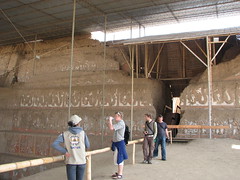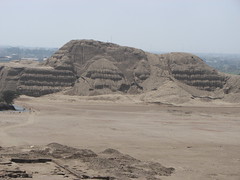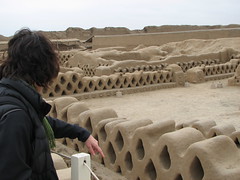Ruinous Excitement
I am proud to say we chose the cuarto without the cockroaches and dirt. It did seem like a fun place, but we can always visit for a beer than retreat to our santuary. We have our own room with a table next to a window overlooking a courtyard of plants. We have a bathroom attached to the room that has a TUB as well as a hot water faucet. Amazing! I must take a bath soon. Plus the room is so much warmer, being on the second floor with windows that close. No dogs on the roof and only one day this week was there construction at 7am…but it was next door, not outside our room. We have access to a lovely roof with a clothesline and views of the ocean. We are sharing the kitchen with the owner and her 20 year old daughter. They are quiet, nice and don’t bug us all the time like Wilma did. (And it’s only 30 cents more a day than Wilma’s!) Plus, in the house there are 3 other sets of couples and a solo computer programmer guy (It’s a big place, but somehow less noisy than where we were). All in all, we are much healthier, happier, warmer and less stressed. We also live next to the best market in town, El Hornito. So any late night cravings for plantain chips can be satisfied. We’re still one block from the beach, but my walk to work is about 15 minutes now.
We have been busy with our volunteer work as well as making time for adventures. This past weekend we visited the Huaca del Sol (y la Luna), which are Moche temples built at the base of a rocky mountain (Cerro Blanco). The Moche people lived from 200 BC to 850 ad and are known for their ceramics, textiles and metalwork. Gold here isn’t found in nuggets, it’s in pieces like mica. So they would just build a big fire and extract the metal out and make impressive breastplates and other accessories out of it.
I’m impressed how advanced they were with the buildings and artwork and how they lived in an organized community with a strong religion. The Huaca del Sol is the largest single pre-Columbian structure in Peru, but about a third of it has been washed away from wind and rain (mud houses DO need some upkeep). It looks like a rough pyramid and it was made completely of mud bricks (estimated 140 million bricks for one pyramid). The thing that amazed me the most visiting the Huaca is that about every 100 years, the Moche people would fill up the current temple with bricks and build a new temple on top of it. The Huaca del Sol has 5 layers, which means 5 temples built upon each other. So all of the previous temples are beautifully preserved because they were covered with bricks. The top of the 5th and final temple was washed away, so we couldn’t really see much of the top of the pyramid. The tour was really interesting because the archaeologists can’t fully expose a previous layer without destroying the current layer. There was one part in the tour where we walked through a giant crack in the North wall, the only designed entrance to the temple, and you can see in the bricks the colors painted on the previous walls. They exposed the layers of the main wall in a way you can see all 5 buildings with their individual carvings and designs. It was beautiful (and scary).
Most of the friezes were of their angry saber-toothed god, Ayapec, and a few of decapitations, naked slaves and shiny happy people holding hands. From the upper level, we could see the ruins of the walls of the village were the common people lived, and the Huaca de la Luna, which still looks like a pyramid and is not open to the public yet. Archaeologists are still slowly digging away, which means there will always be more to see in the future. I think it’s crazy how many ruins are in Peru and have barely been explored. I think most of the sites are waiting for some rich person to will all their money for excavations. I really enjoyed seeing the Huacas, and it was a fun public bus ride through a tiny village of Moche descendants. The Moche built an elaborate irrigation system from the river, and the village around the Huacas is lush, with lots of farms and plants and GREEN. Such a contrast from our current desert dwellings.
Last week we went to see Chan Chan, which is located in between Trujillo and Huanchaco. This place did not have the irrigation nor any communities living close to the ruins. It was dry and dusty. The main road actually cuts through one of the temples, so anyone who commutes to Trujillo or Huanchaco sees the ruins every day. Chan Chan consisted of 9 royal compounds, and only one is restored and available for the public. Chan Chan was not pyramidal like the Huacas, it has high thick walls and it’s a bit maze-like with a lot of hallways and rooms. Since there weren’t any roofs, most of Chan Chan has been eroded by the weather. There was no colorful friezes (although they used to be colored) and most of the friezes were restored (where the Huacas were all original). Their artwork on the walls was less angry God man and more ocean art (pelicans, sea otters, fish and fishnets). The ruins were built around 1300 ad and covered over 28 sq km, which is HUGE. It’s really hard to believe that this many people, without cranes or brick building factories, had accomplished this much work. I am quite the lazy modernized American. It was neat to see the ruins, especially since it’s the largest pre-Columbian city in the Americas and the largest adobe city in the world (according the Lonely Planet). The coolest part of Chan Chan was when we came upon the well. Everything so far in the tour was dry, dusty and eroded. Then we entered this area with basically an Olympic sized swimming pool filled with totora reeds, lily pads and silly ducks that ran on the water and dove under the water for minutes at a time. I had been wondering what a culture living near the ocean did for fresh water and now I know. The Chimu people (of Chan Chan) just kept digging until they hit the groundwater and filled a large enough area to grown their reeds for their fishing boats and have drinking water. There were 3 wells built in the compound we visited, but we only saw the biggest and coolest one. There was a sacrificial alter near the well, too. There’s always the sacrificial alter, which is sad. I don’t know how they choose, but it’s always their own people they kill to appease the gods for more rain. Oh, and the Chimu people lived from 850 ad to 1470 ad. They seemed to be more interested in making huge buildings with lots of walls than elaborate paintings or pottery. They did do a lot more metalwork, as they found a lot of gold and silver buried with the kings (as well as 40 bodies with one king). The Chimu people were eventually conquered by the Incas and seemed to have just died out. I don’t really know why so many distinct cultures in Peru just disappeared, perhaps I will find a guide one day with the answer. So far it’s either warfare, weather, famine or the Spaniards.
Or the dinosaurs ate them all up.



